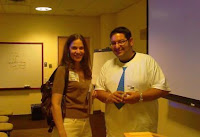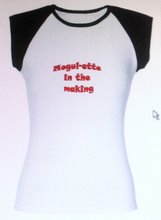 It's never been a better time to start a blog. No matter what field you're in, blogs are increasingly opening doors for publishers and getting us R-E-S-P-E-C-T, as Aretha would say. My friend and fellow blogger, Sharon Toomer, attended the Democratic National Convention along with two of her writers in an all-expense paid trip, truly a dream come true for her, all because of her blog, Blackandbrownnews.com, (BBN for short). Sharon launched BBN about two years ago as a user-driven news, information and community forum to cover stories from the Black and Latino perspective.
It's never been a better time to start a blog. No matter what field you're in, blogs are increasingly opening doors for publishers and getting us R-E-S-P-E-C-T, as Aretha would say. My friend and fellow blogger, Sharon Toomer, attended the Democratic National Convention along with two of her writers in an all-expense paid trip, truly a dream come true for her, all because of her blog, Blackandbrownnews.com, (BBN for short). Sharon launched BBN about two years ago as a user-driven news, information and community forum to cover stories from the Black and Latino perspective.
Naturally, covering the DNC was a plum assignment for Sharon, who's day job is at the Association of Black Foundation Executives. But with limited funds, she boldly decided to ask her employer to sponsor her trip to both the Democratic and Republican conventions, and they said yes. This wouldn't have happened, say, a couple of years ago. How times have changed! (That's her getting some face time with Rep. John Lewis at the convention)
But there's more. She hooked up with the NY Community Media Alliance, who launched an election 2008 initiative and is financing a group of ethnic and immigrant media organizations so they can attend both conventions, as well the primary season and the general election. The NYCMA has also arranged for new media journalists and bloggers to get the all-important press credentials for high profile events, including "Big Tent Denver". There are 11 journalists along with Sharon, representing Pakistan, China, Bangladesh, Ireland, Poland, Russia and of course Black, African American and Latino communities. "None of us has the resources, human or financial, to staff this kind of coverage," says Sharon.
Bloggers and new media journalists had a huge area where they could blog all day, with free lunch and dinner, sponsored by Daily Koz, Google and YouTube. "They're taking bloggers seriously and created a space for us to be able to work," adds Sharon.
Her first interview was with Al Sharpton at La Guardia when they were both boarding the plane from NY to Denver. She saw him waiting to be seated and asked if she could have a few minutes of his time. He was very generous and kind to her. "It was cool", she says. "This is very valuable for nontraditional news and information outlets like BBN that don't have access to the democratic process in the same way that mainstream media does yet we still need to get information to our readers."
Next stop for Sharon: Minnesota. After that? The world!
Saturday, August 30, 2008
Bloggers Get the Full Treatment at the DNC
Posted by
Carmina Pérez
at
8:30 PM
3
comments
![]()
Labels: bbn, bloggers, dnc, sharon toomer
Saturday, August 9, 2008
Social Media Camp Recap
By the time I got to my first session at Social Media Camp, the one-day event at Sun Microsystems on Thursday, Joshua Mack, VP of Network for Outside.in was wrapping up his schpeel on "place blogging", a term I had never heard before (other cool lingo I picked up that day: failwhale - what you get when the Twitter server is busy...). Their software allows you to enter a zip code and track blog conversations people are having in your local area. Very cool.
Twitter was the big theme of the day at this social symposium, and the next session I attended was a case study on how a business uses it. It was led by Saul Colt, Head of Magic at a company called FreshBooks (man, I wish I had a job title like that in my resume!). Saul (that's him with me in the picture below) is obsessed with Twitter and spoke for an hour on how he uses it for the company he works for, which makes online invoicing and billing software. Actually what he does is the opposite of business, because his "tweets", or the messages he sends on Twitter, have absolutely nothing to do with business. For example, he'll send a tweet in support of fellow Twitter-ers if they share a disappointing experience.
he'll send a tweet in support of fellow Twitter-ers if they share a disappointing experience.
Saul believes that we must use the internet to have real-world relationships with people, and twitter-ing is a way to do that. It used to be we knew everything about what was going on with the people in our community, like who had a baby, who went to what school, who was going where on Saturday night, etc. Somehow that got lost as society evolved, but the web is enabling us to find a way back there.
Saul pointed out that he gets 70% of his business from Twitter but says you can't track the effectiveness of word-of-mouth marketing in traditional ways. So he takes out all the things you can track, like promo codes, etc. and the rest is WOM. His last two cents: "Make people feel they're part of something special. Never pitch product - if it's good it will sell itself." Saul's quotable quote: the 4 E's - "execute on extraordinary experiences every day - that's what people will talk about."
From there I moved on to a fascinating discussion given by Loretta Donovan. Her session was titled "Customers, Clients and Social Mediators, When the Wiki Becomes CoLaboratory" (note: the spelling of the last word is intentional). Just in case you're fuzzy on what a wiki is, Wikipedia defines it as "a collection of web pages designed to enable anyone who accesses it to contribute or modify content." This makes for interesting collaborations between employees inside an organization (many of these are private), or anyone within an industry that wants to share knowledge about a specific subject. Loretta took us through the 3 main elements that wikis must have to be effective:
1-Knowledge - meaning information, and to this she suggests adding tags and allowing comments.
2-Integration - with more knowledge, for example, adding links to video or other sources that contribute to your premise. You can add a new page allowing contributors to continuously add and edit information, insert links back to other pages of the wiki, and raise questions that can be answered by other contributors - all this creates quantity.
3-Execution - this is the experimentation phase. Here you can create a prototype of something and then test it, and write about the results of the first test, and the second test, and the third, and so on, always allowing for people to leave comments.
Loretta added that wikis leave a visible path of how our thinking is going. They create a level of transparency for organizations, and a sense of psychological safety among employees - and where people feel safe, creativity abounds.
In the end, however, you need to sustain it. There are many wikis that are started and then forgotten, so you need to have a social mediator in charge of attracting those conversations to keep it going.
Next stop: Howard Greenstein's, interactive session on Twitter, where he posed the question, "how do you use Twitter for business?" to the group. These were some of the responses:
- as a source of news & information
- to participate in the community - answer questions and ask questions
- to alert your community about upcoming events
- to follow interesting writers/conversations
- to send out a daily tip
- to meet like-minded individuals and connect with them locally or when you travel
- to promote awareness of a particular issue
- to offer what you have
Posted by
Carmina Pérez
at
5:59 PM
5
comments
![]()
Labels: social media camp, twitter
Monday, August 4, 2008
Use Widgets to Promote Your Site's Content
When Sheryl Azaroff launched her website two years ago she made a lot of mistakes. She started out on a different direction than where is is today and hired the wrong developer. But in the last year things have come together. "You have an idea in your head about how you want things but what you set out to do and what you actually do end up being different. However, you find out the information you need along the way," says the web entrepreneur.
I met Sheryl recently at a NYSIA event and was intrigued by what was doing with her website, PhysicalFitnet.com, which offers information and resources to both fitness professionals and fitness-minded individuals, mostly in the form of video.
"We have a video library of nearly 900 video clips. Most of them are exercise demos and some are answers to frequently asked fitness questions. We also have workouts for individual exercises. The exercises clips are about 10-15 seconds - very short - to give you an idea of what the exercise is. The FAQs are a little longer, one to one and a half minutes," explains the former personal trainer.
Fitness videos on the internet are a great source for people interested in staying in shape, but Sheryl has taken them one step further. She's making the videos available for syndication, or RSS feeds, which is very handy for fitness bloggers or gyms that have websites and may be looking for fresh, relevant, multimedia content for their sites but don't have the time to make it themselves. Now they can offer their visitors an "exercise of the day", or a "workout of the week" by just plugging in Sheryl's professionally generated videos. The videos are free to either watch directly from her site or syndicate.
Sheryl's Widget Strategy
To makes things really easy, Sheryl has created widgets, like the one you see above, so that once you put the videos on your site they will be updated automatically. That means you will have fresh content every day without having to do anything yourself!
I wrote a post about widgets recently (What's Your Widget Strategy), but to review, they are little pieces of code that you can embed into your site to allow users to do certain things. The "search this site" widget on the top of my sidebar is an example of this. These mini-applications are great ways to promote your business and drive traffic to your site. In Sheryl's case, she's using widgets to showcase her videos and to create awareness for her brand. She offers the widgets on her site and is also using other platforms, such as WidgetBox and Google Gadgets to distribute them. And she's looking for ways to offer it as a Facebook app as well.
She currently offers four types of widgets - one for an exercise of the day, one for a workout of the week, one for a Fitness Q&A for the Day and another one for Exercises by Body Part. All these will automatically be updated for you.
Sites can easily customize the videos they want to syndicate, which is how a blog called Diets in Review is using them. They are focused on the nutrition side but they wanted to start offering content on fitness because it's a topic that's closely related to dieting. Sheryl's videos make their posts more interactive and interesting. In this entry on combination exercises they added 5 of Sheryl's videos to go along with the topic of the post. Once you click on the image, a window will pop up with the video. To monetize it further Sheryl is using Google Adsense to display ads inside the pop-ups. In the future, once she increases her distribution, she hopes to strike deals directly with advertisers.
"Originally when we started I was only going to have content on my site and make money through ads. Now we're thinking of ways to distribute our content as well as sell ads. And there's more ideas related to this to get other people to look at our content. The production and creation are done - now we're leveraging the work that's already completed," explains Sheryl.
What "new media" tools have you used on your site? We'd love to hear about it!
Posted by
Carmina Pérez
at
10:17 AM
0
comments
![]()
Labels: Adsense, Google, physicalfitnet.com, RSS, Sheryl Azaroff, syndication, video, video ads












